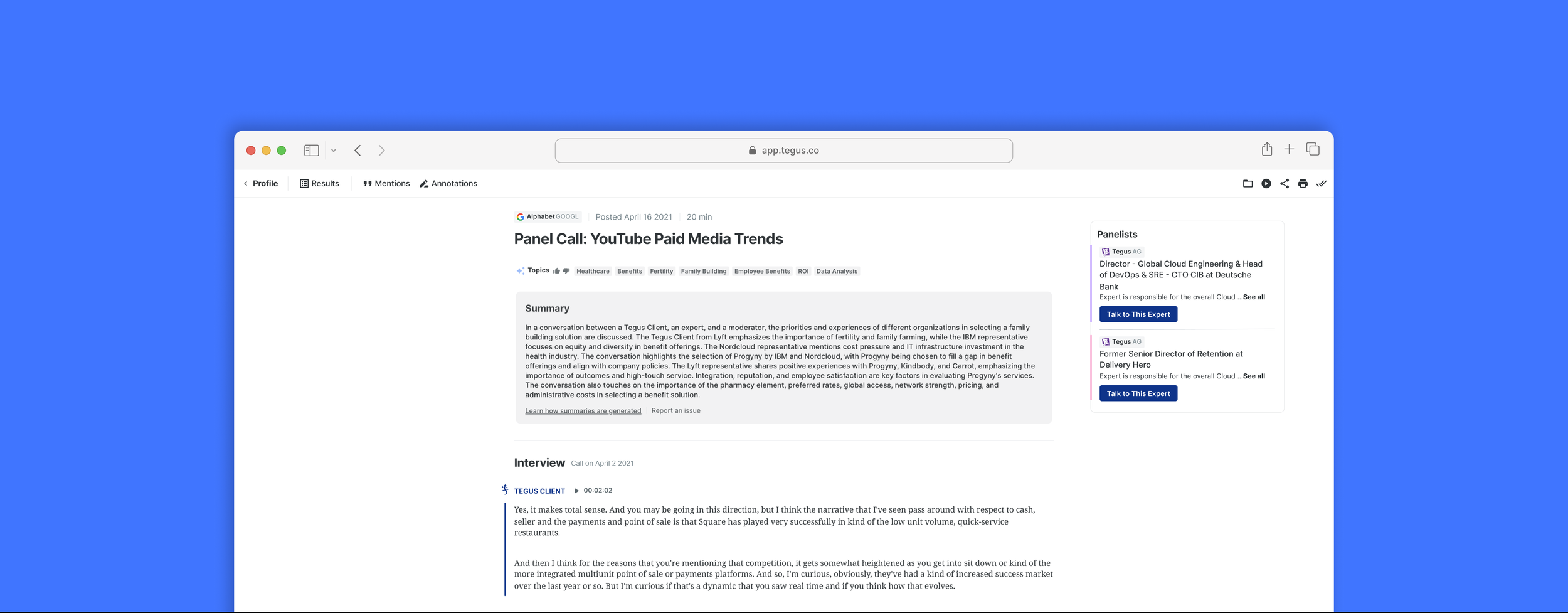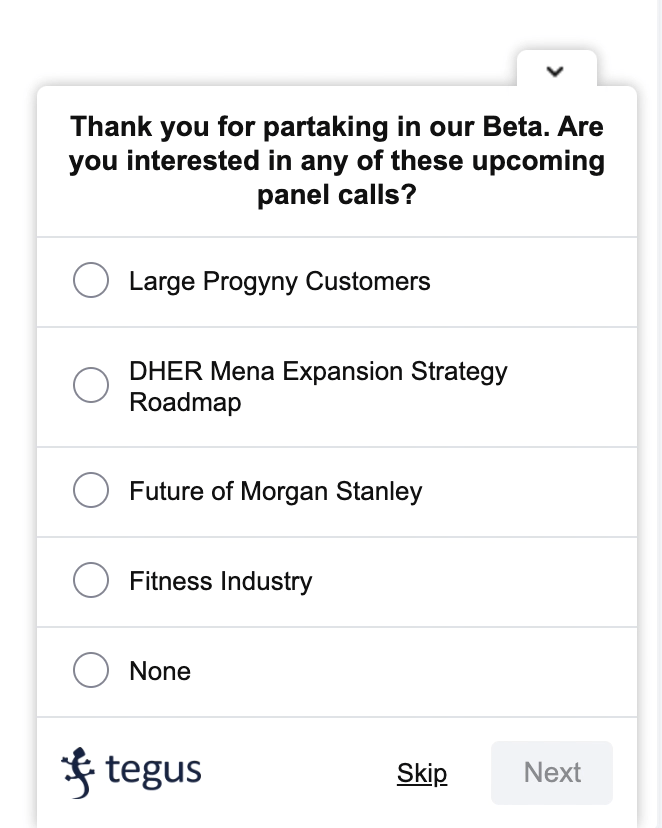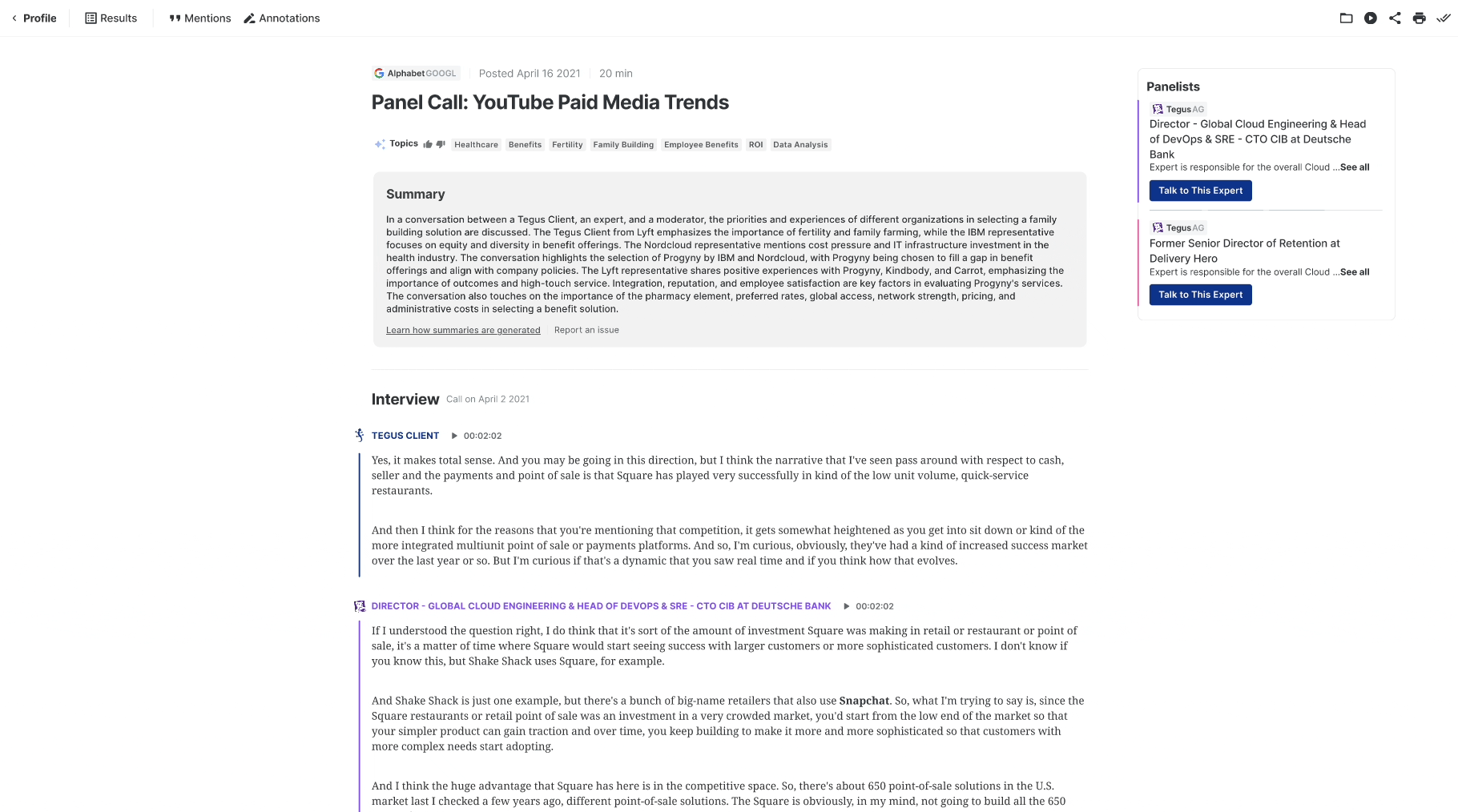
Tegus: Panel Calls
Improving the panel call transcript experience
TIMELINE
May 2023 - Aug 2023
TYPE
Product Design Internship
DISCIPLINE
Product Strategy
UX Research
UX Design
UI Design
TOOLS
Figma
Hotjar
IMPACT
This project shipped in Q3 2023.
CONTEXT
Tegus is a B2B fintech company that helps investors make informed investment decisions through research. Tegus achieves this by setting up and transcribing expert calls between investors and creating an extensive library of information.
Until now, Tegus has primarily offered one-on-one expert calls as its core content. Tegus is now exploring new avenues of content, starting with panel calls and has already released a beta version.
1:1 calls and panel call transcripts are uploaded in the same format. However, there are differences that make panel call transcripts difficult to consume, leading users to avoid using panel calls.
THE PROBLEM
User goals
Save time getting necessary insights for investment decisions
Find value in panel calls
Business goals
Introduce new content to diversify database
Increase panel calls engagement
PROJECT GOALS
01
DISCOVER
Starting my project with the broad goal to improve panel calls, I needed to identify the opportunities for improvement within panel calls.
✦️ IDENTIFYING OPPORTUNITIES
What did we have before??
The current process Tegus uses for panel calls in the beta version is:
OPPORTUNITY #1
This is a time-consuming, manual process done by the Operations team, making it costly for the business and difficult to scale.
OPPORTUNITY #2
Transcripts of panel calls and 1:1 calls are uploaded in the same format. The key differences between them make panel call transcripts difficult to consume.
✦️ EXPLORING OPPORTUNITIES
Given the time constraints of my internship, it was crucial to focus on addressing the most prioritized problem. To ensure that I was tackling the correct issue, I used an Opportunity Solutions Tree to thoroughly explore all possible opportunities and solutions.
02
DEFINE
Taking my opportunities and solutions, I needed to see what really mattered and narrow down my scope.
✦️ CONCEPT TESTING
But what do users really care about?
I put my concepts in front of users to determine what solutions users prioritize. Through these concept tests, my goal was to evaluate users' willingness to engage with the proposed solutions and gather their initial reactions.
My concept testing methods were:
Hotjar survey
User interviews
The Hotjar survey was presented to 350+ beta users, and I conducted 7 user interviews, involving 5 beta users and 2 non-beta users. During the user interviews, I shared high-fidelity prototypes of my designs and posed questions to gather insights on the explorations.
Slides from the user interviews
The Hotjar survey
✦️ SCOPING DOWN
While users were very enthusiastic about the new explorations in panel calls, it was repeatedly emphasized that the existing transcript experience was a significant factor leading current beta users to avoid reading the panel call transcripts.
Therefore, I narrowed the focus of my project to:
How might we redesign panel call transcripts to boost user engagement and address the distinct differences between panel calls and 1:1 calls?
03
DISCOVER… AGAIN
With my refined project focus, I set out to understand users' specific issues with panel call transcripts.
✦️ IDENTIFYING PAINPOINTS
By reading customer feedback, conducting internal workshops, and synthesizing insights from user interviews, I discovered the main differences between panel call transcripts and 1:1 call transcripts and identified the pain points caused by those differences.
📏
TRANSCRIPT LENGTH
Panel calls generate longer transcripts due to multiple experts speaking, while 1:1 calls involve only two parties and result in shorter transcripts.
ℹ️
EXPERT CONTEXT
In panel calls, the lack of contextual clarity about experts at the beginning of transcripts makes it challenging to follow each expert's viewpoints.
🔊
AUDO LIMITATIONS
Currently, audio is not available for panel calls due to limitations in handling multiple voices. This limitation is not a concern in 1:1 calls.
👀
VISUAL CUES
In panel calls, the lack of visual cues to differentiate panelists impedes speaker identification, a less significant concern in 1:1 calls with only two participants.
PAIN POINT #1
Panel call transcripts are difficult to digest and consume.
🎯
PURPOSE
Panel calls are primarily a starting point for research, while 1:1 calls provide deeper insights for making investment decisions.
PAIN POINT #2
Users are unclear how to use panel calls for their research.
DESIGN
04
My final designs tackled the issues that users were facing with the existing format of panel call transcripts.
I focused on two main aspects: first, making panel call transcripts easier to digest, and second, using panel calls as a starting point for research.
FINAL DESIGNS
Making panel call transcripts easier to digest
Clear visual indicators that make it easy to follow who is speaking
Expert bios with more information about the expert on hover
Floating expert bios that make it easy to keep track of the different panelists and schedule a follow up call
Using panel calls as a starting point for research
Links to jump off from the transcript to dive deeper into research
✦️ RESEARCH INSIGHTS ANSWERED
INSIGHT
Panel call transcripts are difficult to digest and consume
Users are unclear how to incorporate panel calls into their research
Clear visual indicators
Expert bios on hover
Floating expert bios
Links to jump off panel call transcripts
MY SOLUTIONS
FINAL REFLECTION
★
I learned a TON during my time at Tegus. Navigating a fast-growing startup with an innovative culture was truly a journey. I faced constant challenges from my projects, every designer on the team, the startup culture, and the collaborative work among the product and engineering squads.
I was given zero intern BS and I worked like a full-time employee, which was challenging but allowed me to grow to love the challenging aspects of a B2B company and designing for complex users.
My wonderful mentor, Veronica ❤️
✦️ WHAT I LEARNED
My project timeline constantly shifted during my internship. New research discoveries, internal discussions, and business limitations molded my project and provided me with genuine experience in navigating the practical aspects of design in a business context. I gained valuable insights since my project involved a new feature without a predefined timeline or goal from the product teams, enabling me to independently set the timeline and direction.
Designing when constant adaptation is essential
During my internship, I had countless questions about the business, our users, company culture, and beyond. My mentor has emphasized repeatedly to never hesitate in asking questions. Posing a multitude of questions throughout my tenure enabled me to attain an extensive comprehension of Tegus as both a business and a product. This insight significantly aided my design process, facilitating confident design decisions backed by knowledge.
Never be afraid to learn more and ask questions
SEE MORE PROJECTS






